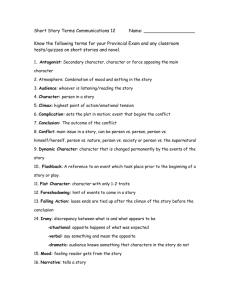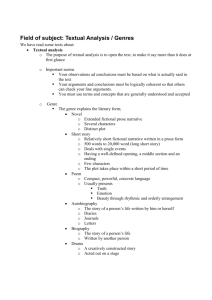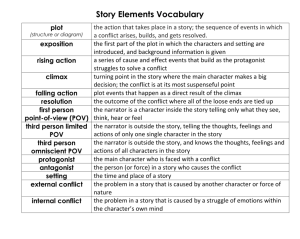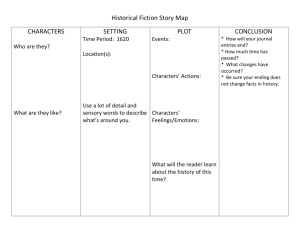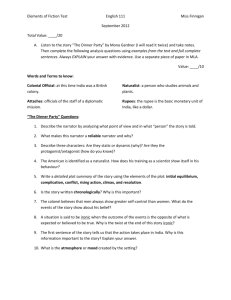IED 281 (02) THE SHORT STORY 2012 FALL
advertisement
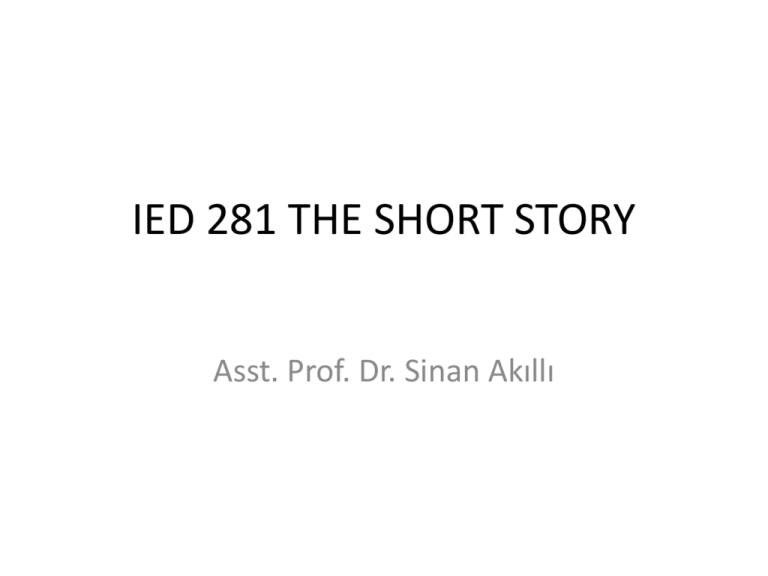
IED 281 THE SHORT STORY Asst. Prof. Dr. Sinan Akıllı WHAT IS THE SHORT STORY? • Short Story, a fictional prose tale of no specified length, but too short to be published as a volume on its own, as novels usually are. A short story will normally concentrate on a single event with only one or two characters, more economically than a novel's sustained exploration of social background. – Chris Baldick, The Concise Oxford Dictionary of Literary Terms WHAT IS THE SHORT STORY? • Short Story: A short story is a brief work of prose fiction, and most of the terms for analyzing the component elements, the types, and the narrative techniques of the novel are applicable to the short story as well. The short story differs from the anecdote—the unelaborated narration of a single incident—in that, like the novel, it organizes the action, thought, and dialogue of its characters into the artful pattern of a plot, directed toward particular effects on an audience. – M. H. Abrams & Geoffrey Galt Harpham, A Glossary of Literary Terms WHAT IS THE SHORT STORY? • In athletic terms, if we take the novella as a ‘middledistance’ book story, then the short story comes into the 100/200 metre class. Nevertheless, there are very long short-stories and very short ones. D. H. Lawrence's The Fox (1923) is about 3o,ooo words; Kleist's ghost story Das Bettelweib von Locarno (1810) is only 800 words. In his preface to his Complete Short Stories Somerset Maugham remarks that the shortest item runs to about 1,600 words and the longest to about 20,000 words. The vast majority of short stories would fall somewhere between the two. – J.A. Cuddon, The Penguin Dictionary of Literary Terms and Literary Theory WHAT IS THE SHORT STORY? • The literary form short story is usually defined as a brief fictional prose narrative, often involving one connected episode. […] Unity of effect is the story’s most characteristic feature. […] The short story is a concentrated form, dependent for its success on feeling and suggestion. – Ann Charters, The Story and Its Writer WHAT IS THE SHORT STORY? • Concentrated work of fictional prose, usually between 1,600-20,000 words in length, involving one connected episode, artistically organized and constructed, directed towards creating a unified emotional and intellectual effect on the reader by way of feeling and suggestion, and not published as a volume on its own. WHAT IS THE SHORT STORY? • Concentrated (intensive use of literary devices: begins in medias res or close to climax; uses symbols instead of lengthy description of social-historical background and/or characters) • fictional (not factual, re-presentational not presentational) • prose (narrative style, prose devices) • one connected episode (no sub-plots) • artistically organized and constructed (setting, plot structure, action, flashbacks, characters and characterization, symbols etc.) • unified emotional and intellectual effect (theme, message, thesis) • on the reader by way of feeling and suggestion (point of view, tone, mood, language, style) HISTORY OF THE SHORT STORY • Probably the most ancient of all literary forms; the term covers everything from the fable, folk-tale or fairy story to such sophisticated and highly developed structures as the German novelle via the stories of the Decameron. Like the epic, short fiction goes back in time far beyond the art of writing. HISTORY OF THE SHORT STORY • It was only at the beginning of the nineteenth century that short fiction, because of the requirements of magazines of everwidening circulation, came into its own and attracted notable writers to practise it, like Pushkin, Edgar Allan Poe, Henry James, Anton Chekhov, James Joyce, Thomas Mann, Franz Kafka and D. H. Lawrence, as well as those like Maupassant and Katherine Mansfield who excelled in this particular genre. HISTORY OF THE SHORT STORY • Earliest tales are of oral tradition, the creation myths. • Next important stage, the period beast fables: animals are shown acting like humans to teach a moral lesson. Aesop (620-560 BC) • Religious parable: a short story with a moral twist, for instance, Cain and Abel, the prodigal son. HISTORY OF THE SHORT STORY • Medieval period: short narratives mostly in verse. Heroic episodes (Battle of Maldon) and lowlife comic tales of French origin fabliaux. • Eastern stories being introduced to Europe. (Arabian Nights) • Prose usually reserved for devotional and instructional pieces until the 14th century. • Giovanni Boccaccio’s short prose tales Decameron (1353) , Geoffrey Chaucer’s Canterbury Tales (1387). Pleasure and moral instruction. Framed-tale device. • Moral and religious values in narratives continue during the Renaissance. HISTORY OF THE SHORT STORY • 18th century, secularization, fictional narratives began to evolve into forms we recognize as close relations of modern stories and novels. • These forms developed in periodicals popular with readers from the emerging middle class who had the time and money to enjoy them. • Periodicals became a market for professional writers of stories (character sketches, satires, gothic tales, adventure stories). HISTORY OF THE SHORT STORY • Romantic period: Originality and imagination valued above all other qualities in writing. Horror stories and criminal stories became popular. • The short story did not appear until the nineteenth century, when original prose works emerged, in which every word chosen and every detail of description and characterization contributed to a unified impression. • Germans first experimented with this new form. Brothers Grimm are the most famous German writers in early 19th century. They published a collection of folk and fairy tales. HISTORY OF THE SHORT STORY • In the USA: Washington Irving (1783-1856) was inspired by German writers and created American versions of European folktales. “Rip Van Winkle” and “The Legend of the Sleepy Hollow,” earliest short stories appeared in 1819-20. • Sir Walter Scott published the first modern short story in England: “The Two Drovers” HISTORY OF THE SHORT STORY • Nathaniel Hawthorne and Edgar Allan Poe are credited as the first American writers to create a considerable number of successful short stories. • Poe was the first person to theorize on the short story. • Herman Melville HISTORY OF THE SHORT STORY • Mid-19th century romanticism gave way to realism. • Stories that reflected everyday reality. Characters’ psychology is manifested in the things said and done by characters themselves. • Late 19th century masters of the short story proper: – Americans: Henry James, Edith Wharton, Stephen Crane, Jack London – Europeans: Guy de Maupassant (French), and Anton Chekov (Russian) HISTORY OF THE SHORT STORY • Maupassant: tightly organized plots, conclude with decisive action. Details of characters’ physical appearance given in narrative. • Chekov: Plots include less decisive action. Dramatization of characters’ psychology and mood. • Modernist writers of early 20th century were influenced by Chekov’s style. Interiorized plot. – European Modernists: Joseph Conrad, Virginia Woolf, James Joyce, Franz Kafka, D.H. Lawrence, Katherine Mansfield – American Modernists: William Faulkner, Ernest Hemingway HISTORY OF THE SHORT STORY • The form has flourished especially in America; Frank O’Connor has called it “the national art form,” and its American masters include (in addition to the writers mentioned above) Mark Twain, William Faulkner, Katherine Anne Porter, Eudora Welty, Flannery O’Connor, John O’Hara, J. F. Powers, John Cheever, and J. D. Salinger. HISTORY OF THE SHORT STORY • Two types of stories being written today: • Traditional stories: descending from Poe and Maupassant, which are plotted and closed. • Modern stories: descending from Chekhov and Joyce, which are less plotted and more open. COMPONENTS OF A SHORT STORY • Plot: The sequence of related events composing the narrative, • Characters: The persons who play their parts in the narrative. • Setting: The place and time in which the story’s action occurs. • Point of view: Establishes a consistent perspective on the characters and their actions. • Style: The way the author uses the resources of language. • Theme: The unifying idea that brings to life all other elements of fiction. PLOT • The sequence of events in a story and their relation to one another. Usually they are related by causation. • It sustains the illusion of reality. • Plot can be carried forwards not only by the description of events, but also by the outgrowth of a character’s will, the dialogs between characters, an apparent accident or fate, and even the setting. • It can proceed chronologically or by flashbacks, and dream sequences. • The beginning sets up the problem or conflict; the middle is where various complications that prolong the suspense are introduced; the end resolves the conflict to a greater or lesser degree. PLOT • Exposition: Introduces characters, scene, time and situation. Usually brief. – PART OF THE NARRATIVE BUT NOT PART OF THE PLOT • Rising Action: The dramatization of events that complicate the situation and gradually intensify the conflict. • Climax: The turning point of the story, its emotional high point. The pace of the narration breaks off at this point. • Falling Action: The problem or conflict proceeds toward resolution. • Resolution/Denouement: The final paragraph. Usually brief. Often contains an element of surprise. PLOT STRUCTURES CHARACTERS • The chief character in a plot, on whom our interest centers, is called the protagonist (or alternatively, the hero or heroine), and if the plot is such that he or she is pitted against an important opponent, that character is called the antagonist. • A character in a work who, by sharp contrast, serves to stress and highlight the distinctive temperament of the protagonist is termed a foil. CHARACTERIZATION • Created through description (appearance) and action (verbal and dramatic). • Flat character (flat, passive) • Round character (more real, capable of alternatives, active) • Static character (does not change) • Dynamic character (changes) SETTING • Helps make the characters seem real. • Setting must have a dramatic use, to be most effective must affect character or plot. • Might have symbolic function. POINT OF VIEW • The way the story is told. • Should be in accordance with the complete dramatic ordering of the subject. • First person narrator: “I” – Narrator a participant in the story • A major character • A minor character • Third person narrator: “he,” “she,” “they” – Narrator a nonparticipant in the story • Omniscient (seeing into all characters) • Limited omniscient (seeing into one or two characters) FIRST-PERSON NARRATOR • Can move freely in the fictional world. • Has no way of understanding the other fictional characters except by observation of what they say and do. • The authority of FPN is limited. • Only an eyewitness. THIRD-PERSON NARRATOR • Omniscient TPN knows all there is to know about all the characters, both inside and out. • May be judgmental or impartial. STYLE • The specific way the author uses language in narration. • Made up of various elements including, • Tone: the way the writer uses the words to convey unstated attitudes toward the subject. Humorous, serious, excited, compassionate • Irony: Belief in and exploitation of the difference and distance between words (verbal irony) and events (situational irony) and their contexts. • Symbols: An object, animate or inanimate, that stands for something else. Symbols are specific images (visual ideas) that tell more than paraphrases. THEME • • • • A generalization about the meaning of a story. What the story is about. Usually a word or phrase. The theme must be true to any and all of the specific details in the narrative. • All other elements of fiction must be accounted for in determining the theme. HOW TO ANALYZE A SHORT STORY • EXPOSITION – What do we learn about the characters that prepares us for the conflict in the story? – Where and when the story is set? Is the setting essential to the working of the story? How does the setting contribute to the story’s mood? – What is the significance of the title of the story? How does it prepare us for the action? HOW TO ANALYZE A SHORT STORY • CHARACTERIZATION – Who is the protagonist? What are his/her main personal characteristics? – Do we tend to admire/dislike the protagonist? If so, on what basis? – Who is/are the antagonist(s) and foil(s), if any? – Which characters are round/flat and dynamic/static? – Are the characters described or do we understand them by their actions and dialog? – Are their names significant, do they tell about the characters? – Does any one character seem to speak for the author? HOW TO ANALYZE A SHORT STORY • PLOT – What is the plot structure? – What is over when the story is over? Has a central conflict been solved? – Is the primary change in external circumstances (health, well-being, wealth, power, relationships) or is it primarily internal (moral character, philosophical outlook, emotional maturity etc.)? – Does the story contain strong elements of suspense (anticipation, curiosity)? – Does the protagonist control his/her fate through his/her moral decisions? Is his/fate controlled by other characters, environment, good or bad luck, divine providence? HOW TO ANALYZE A SHORT STORY • CONFLICTS – What is the central conflict? Is it external or internal? • • • • • • • [wo]man vs. nature [wo]man vs. [wo]man [wo]man vs. the environment [wo]man vs. machines/technology [wo]man vs. the supernatural [wo]man vs. self [wo]man vs. god/religion HOW TO ANALYZE A SHORT STORY • NARRATIVE TECHNIQUE – Is the entire plot narrated in the story? Anything omitted and left for the reader to infer? – Is the narration in chronological order? Any flashbacks? If so, how would the story change without them? – What is the point of view? If FPN, is the narrator the protagonist, a minor character, an observer? If TPN, is the narrator which character(s) are in focus, is the attitude ‘objective’? – Is the narrator conscious of the act of telling a story? – What elements of plot are dramatized and what are narrated? – Do we identify with one or more of the characters? Does the author encourage emotional involvement? HOW TO ANALYZE A SHORT STORY • STYLE, DICTION, LANGUAGE – What devices of language (figures of speech or unusual vocabulary) are used to set mood in the story? – Do all characters use the same language? – Any recurring words or patterns of imagery? – Do any objects seem to be symbolic? How do they function in the story? – Is the dialog colloquial? Or is it stylized or unusual? What purpose is served by unrealistic dialog? – Are there sentences too long or complex? Is the vocabulary highly unusual? HOW TO ANALYZE A SHORT STORY • THEME & MESSAGE – Does the story embody a central theme, a moral or intellectual problem that can be abstracted from the concrete action? – Is the story organized around a message? What is that message? Is it explicitly stated in the story or is it implicit so that it needs to be inferred by the reader? HOW TO ANALYZE A SHORT STORY • MODE AND GENRE – Does the story belong more or less to any of the traditional classes of fiction such as: the realistic novel, the Gothic romance, the tale of adventure, the fairy tale, or science fiction. – Is the story a retelling of some older story, a folk tale, a story from mythology etc.
